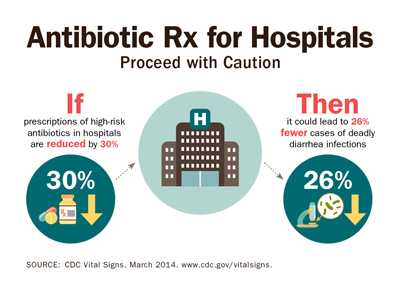Improving Antibiotic Prescribing in Hospitals Can Make Health Care Safer
CDC calls on every hospital to use new checklist to improve prescribing practices
This website is archived for historical purposes and is no longer being maintained or updated.
Press Release
Embargoed for: Tuesday, March 4, 2014, 1:00 ET
Contact: Media Relations
(404) 639-3286

Antibiotic Rx for Hospitals; Proceed with Caution. If prescriptions of high-risk antibiotics in hospitals are reduced by 30%, then it could lead to26% fewer cases of deadly diarrhea infections; Source: CDC Vital Signs. March 2014.
http://www.cdc.gov/vitalsigns.
A new Vital Signs report from the Centers for Disease Control and Prevention shows that clinicians in some hospitals prescribe three times as many antibiotics than clinicians in other hospitals, even though patients were receiving care in similar areas of each hospital. In addition, about one-third of the time, prescribing practices to treat urinary tract infections and prescriptions for the critical and common drug vancomycin included a potential error – given without proper testing or evaluation, or given for too long.
The report also found that, in hospitals, a 30 percent reduction in use of the antibiotics that most often cause deadly diarrheal infections with Clostridium difficile can reduce these infections by more than 25 percent. The same antibiotics also prime patients for future super-resistant infections.
"Improving antibiotic prescribing can save today's patients from deadly infections and protect lifesaving antibiotics for tomorrow's patients," said CDC Director Tom Frieden, M.D., M.P.H. "Health care facilities are an important part of the solution to drug resistance and every hospital in the country should have a strong antibiotic stewardship program."
More than half of all hospitalized patients will get an antibiotic at some point during their hospital stay. The Vital Signs report showed that the most common types of infections for which hospital clinicians write prescriptions are urinary tract infections, lung infections and suspected infections caused by drug-resistant Staphylococcus bacteria, such as MRSA.
To help hospitals, whether large or small, develop antibiotic prescribing improvement programs (also called "antibiotic stewardship" programs), CDC released practical tools that include seven key elements, a self-assessment checklist, and an in-depth implementation document.
Checklist to Improve Antibiotic Prescribing
CDC recommends that every hospital implements a stewardship program that includes seven core elements:
- Leadership commitment: Dedicate the necessary human, financial, and IT resources.
- Accountability: Appoint a single leader responsible for program outcomes. Physicians have proven successful in this role.
- Drug expertise: Appoint a single pharmacist leader to support improved prescribing.
- Act: Take at least one prescribing improvement action, such as requiring reassessment of prescriptions within 48 hours to check drug choice, dose, and duration.
- Track: Monitor prescribing and antibiotic resistance patterns.
- Report: Regularly report prescribing and resistance information to clinicians.
- Educate: Offer education about antibiotic resistance and improving prescribing practices.
It is also critical to work with other health care facilities in the area to prevent infections, transmission, and resistance.
Through the National Healthcare Safety Network, the nation's most widely used healthcare-associated infection (HAI) tracking system, CDC is working to provide facilities, states, regions, and the nation with data needed to identify problem areas, measure progress of prevention efforts, and ultimately eliminate healthcare-associated infections.
"Today's antibiotics are miracle drugs, but they are endangered," said Arjun Srinivasan, M.D. CDC medical epidemiologist. "These new materials provide core elements and practical tools for beginning and advancing antibiotic stewardship programs."
The Vital Signs report follows several calls to action from CDC on antibiotic resistance including the Antibiotic Resistance Threats to the United States, 2013 report, the 2013 Get Smart about Antibiotics Week, and the upcoming Transatlantic Taskforce on Antimicrobial Resistance 2013 report.
CDC's Division of Healthcare Quality Promotion works to ensure patients are safe wherever they receive safe medical care. Ensuring that clinicians prescribe antibiotics correctly is critical to patient safety.
Vital Signs is a CDC report that appears on the first Tuesday of the month as part of the CDC journal Morbidity and Mortality Weekly Report, or MMWR. The report provides the latest data and information on key health indicators. These are cancer prevention, obesity, tobacco use, motor vehicle passenger safety, prescription drug overdose, HIV/AIDS, alcohol use, health care-associated infections, cardiovascular health, teen pregnancy, food safety and developmental disabilities.
###
U.S. DEPARTMENT OF HEALTH AND HUMAN SERVICES
- Page last reviewed: March 4, 2014 (archived document)
- Content source:
Error processing SSI file


 ShareCompartir
ShareCompartir